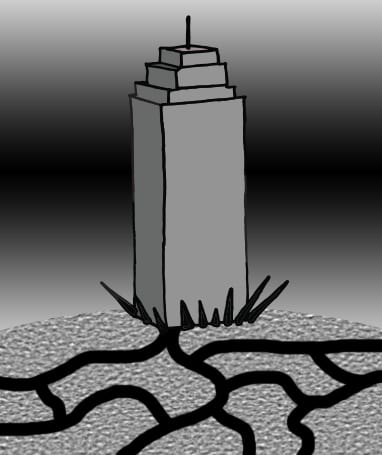
There has been a recent trend in city design labeled “defensive” or “disciplinary” architecture, where a city will install various structural impediments, primarily to make it more difficult for those who are homeless to live on the streets. Some are blatant, such as setting up spikes outside of a store to stop loiterers from hanging around or lying down, while some are less obvious, such as splitting a bench with a metal bar so that multiple people can sit adjacent, but one person isn’t capable of lying down. Things like this seem innocuous to the average observer, but are obvious and devastating to those who rely on them for shelter.
This attempt to combat homelessness is flawed in that it simply serves to make the lives of the homeless harder rather than helping them with their situation. The fact about homelessness is that it appears simple until you put thought into the impact it can have on a life. Being impoverished to the point of having no place to live isn’t merely an aspect of your life, but a circumstance that seeps into all facets of it and begins to define you as a person, at least to the average observer. Any given person seen on the street begging is likely not the figure many perpetuate, who capitalizes off the general public’s goodwill and then steals away to a posh apartment and washes the grime off of his face with a monogrammed towel and filtered tap water. Rather, many are people who may have close to nothing, people for whom finding a place to sleep that night is such an immediate concern and perpetual means of insecurity that things other people assume are accessible, such as searching for a job, take a back seat.
Humans are creatures of habit and constancy. Even in small doses, it’s something that we thrive on. We build on needs, and when one basic necessity is satiated, it makes it easier to pursue other drives, building essentially from primary biological necessities to a pursuit of happiness or self-actualization. When you lack a very basic need, such as readily available food or shelter, the search for those resources dominates your being. It is almost impossible to shift focus onto higher level drives, such as finding job security or meaningful interpersonal relationships. If, at a job interview, you lack the certainty that you will be able to have a warm, safe place to sleep afterward, focusing entirely on the interview is more or less an impossible request. No matter how hard someone works to pursue these less pressing needs, if they are held up at the base survival level, their attention will always be divided.
All of this is why “defensive” architecture, and other similar attempts to fight homelessness work against the goal of ending poverty. Making life on the streets harder as a preventative measure operates under the delusion that being homeless is a willful choice and those who lead that lifestyle do so because it is preferable to them. The truth of the matter is that making a park bench a less reliable place to sleep simply complicates the life of the person who uses that bench as a stable bed, and will further distract them from accessing resources that might change their situation.
This is the impact that “defensive” architecture truly has. There is an old American adage that represents this attitude fairly well and is often hurled at those fallen on hard times. Those who are struggling should simply “pull themselves up by their bootstraps” and work out of a situation. While hardly ever applicable, in this context, the statement feels directed at people not simply barefoot, but with their hands recently bound behind their backs.
Conlan Campbell ’18 campbe1@stolaf.edu is from Burnsville, Minn. His major is undecided.
Graphic Credit: ETHAN BOOTE/MANITOU MESSENGER

